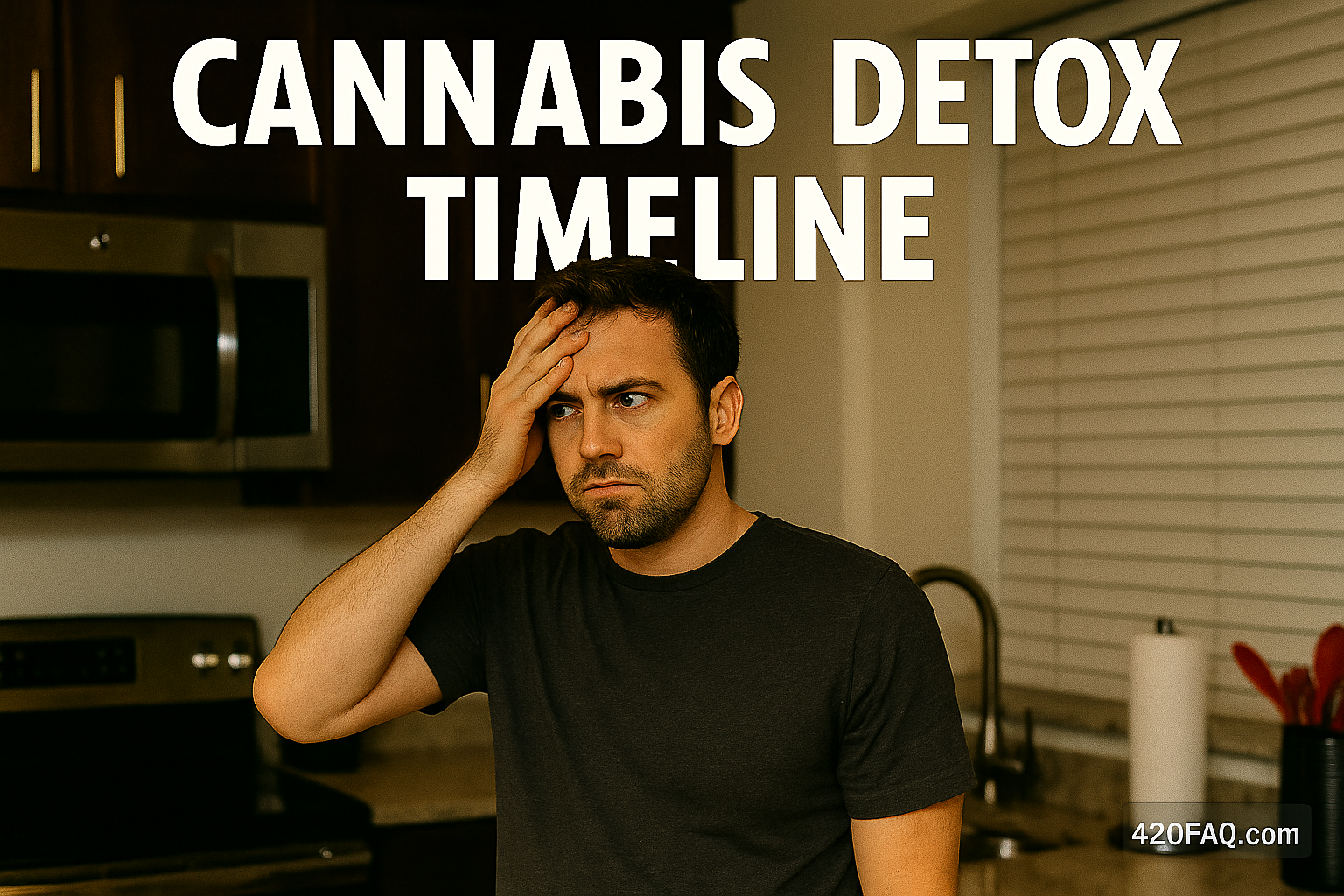
Cannabis Detox Timeline: Comprehensive Guide to THC Elimination and Recovery
Understanding the cannabis detox timeline represents crucial knowledge for individuals seeking to eliminate THC from their systems, whether for employment testing, personal health goals, legal requirements, or recovery from cannabis dependence. The marijuana detoxification process involves complex physiological changes as the body metabolizes and eliminates cannabinoids, with timelines varying significantly based on usage patterns, metabolism, body composition, and detection methods. Comprehending how long cannabis remains detectable, what happens during each phase of detoxification, and which factors influence elimination rates empowers individuals to navigate the detox process with realistic expectations and appropriate strategies.
Understanding Cannabis Metabolism and Detection
Cannabis detox timeline fundamentals begin with understanding how THC (tetrahydrocannabinol) and its metabolites are processed, stored, and eventually eliminated from the human body through various physiological pathways and mechanisms.
The relationship between cannabis consumption and body storage is complex and prolonged. When marijuana is consumed, THC rapidly enters the bloodstream and distributes throughout the body, with significant accumulation in fatty tissues where it can remain for extended periods. The lipophilic (fat-loving) nature of THC means it stores in adipose tissue and releases slowly over time, creating detection windows far longer than the acute intoxication period and making complete elimination a gradual process measured in days, weeks, or even months depending on usage history.
Effective understanding of cannabis detox timelines recognizes that elimination rates vary dramatically between individuals based on metabolism speed, body fat percentage, hydration levels, physical activity, age, genetics, and liver function. These individual differences mean that standard timelines represent averages, with actual detoxification periods potentially shorter or longer for specific individuals.
The prevalence of cannabis testing is substantial across employment screening, legal proceedings, athletic competitions, medical monitoring, and recovery programs. Studies indicate that marijuana remains the most commonly tested substance, with millions of drug tests administered annually. Understanding detection timelines for different testing methods (urine, blood, saliva, hair) is essential for individuals facing screening requirements.
Stages of Cannabis Detoxification
The cannabis detox timeline unfolds through distinct physiological stages from last use through complete elimination, each characterized by specific metabolic processes, detection windows, and bodily changes requiring different timeframes based on usage patterns.
The immediate post-use period (0-24 hours) involves peak THC blood concentrations followed by rapid initial decline as cannabinoids distribute throughout body tissues. During this acute phase, THC is highly detectable in blood and saliva while beginning to accumulate in fat stores. Metabolization into THC-COOH (the primary metabolite detected in urine tests) occurs rapidly in the liver during these initial hours.
Early detox phases (1-7 days) show continued metabolization and initial elimination through urine and feces as the body processes stored cannabinoids. For infrequent users, this period may achieve negative urine test results, while regular users remain clearly positive throughout this week. Physical withdrawal symptoms typically peak during this timeframe for dependent users, though detoxification continues regardless of symptom presence.
The intermediate elimination period (1-4 weeks) involves ongoing release of THC from fat stores with gradual metabolite clearance from the system. Occasional users typically achieve negative results within this window, while regular users show declining but still detectable metabolite levels. The rate of elimination slows as remaining cannabinoid stores decrease.
Extended detoxification phases (1-3 months) affect heavy, long-term cannabis users whose substantial fat-stored THC requires prolonged elimination periods. During these extended timelines, metabolite levels gradually approach detection thresholds, with factors like exercise, weight loss, and metabolism influencing final clearance rates.
Complete system clearance represents the point when all THC metabolites fall below detection limits for standard testing methods, typically occurring within days for one-time users, weeks for occasional users, and potentially months for chronic heavy users. Hair follicle testing can detect use for significantly longer periods (up to 90 days or more) due to different detection mechanisms.
Detection Windows by Testing Method
Various cannabis testing methods detect different compounds and metabolites with distinct detection windows, making understanding of specific timelines essential for individuals facing particular testing scenarios or attempting to determine their detoxification status.
Urine testing represents the most common cannabis detection method, screening for THC-COOH metabolite rather than active THC. Detection windows vary dramatically: single use (3-7 days), occasional use 2-3 times weekly (10-18 days), regular use 4-5 times weekly (20-35 days), daily use (30-60 days), and heavy daily use (60-90+ days). These windows assume standard 50 ng/mL cutoff levels, with more sensitive tests detecting cannabinoids longer.
Blood testing detects active THC and provides shorter detection windows reflecting recent use rather than historical consumption. THC typically remains detectable in blood for 1-2 days for occasional users and 3-7 days for regular users. Blood tests are often used to establish impairment timing in legal contexts since elevated blood THC levels correlate more directly with recent consumption and potential intoxication.
Saliva testing detects THC in oral fluids with detection windows of 1-3 days for most users, though some studies show detection up to 7 days for chronic users. This method identifies recent use and is increasingly popular for roadside testing since collection is non-invasive and detection periods roughly correspond to impairment timelines.
Hair follicle testing provides the longest detection window, identifying cannabis use for approximately 90 days and potentially longer depending on hair length. This method detects THC and metabolites incorporated into growing hair shafts, providing historical use information rather than indicating current impairment or recent consumption. Hair testing is less common but used in certain employment, legal, and forensic contexts.
Sweat patch testing involves wearing an adhesive patch that collects perspiration over extended periods (typically 7-14 days), detecting drug use during the monitoring period. This method sees limited application but may be used in certain probation, child custody, or workplace monitoring scenarios.
Factors Affecting Detox Timeline
Cannabis detox duration varies significantly between individuals based on numerous biological, behavioral, and environmental factors that influence THC metabolism, storage, and elimination rates, making personal timelines potentially shorter or longer than average estimates.
Frequency and duration of use represent the most significant factors determining cannabis detox timelines. Single-use occasions clear rapidly (days), occasional use extends detection (1-2 weeks), regular use prolongs elimination (3-5 weeks), and chronic daily use creates the longest timelines (1-3+ months). Years of heavy use can result in detectable metabolites for 90+ days after cessation.
Body composition profoundly affects THC storage and release, with higher body fat percentages correlating with longer detection windows since cannabinoids accumulate in adipose tissue. Individuals with lower body fat typically metabolize and eliminate THC faster than those with higher fat percentages, though this relationship is complex and interacts with other factors.
Metabolic rate influences how quickly the body processes and eliminates THC and its metabolites. Individuals with faster metabolisms generally achieve quicker clearance, while slower metabolic rates prolong detection windows. Age, genetics, thyroid function, and overall health status all contribute to metabolic speed.
Hydration levels affect urine concentration and can influence test results, though hydration alone cannot accelerate actual THC elimination. Proper hydration supports kidney function and optimal elimination processes, but excessive water consumption immediately before testing may temporarily dilute urine below detection thresholds without actually removing cannabinoids from the body.
Physical activity impacts detox timelines through multiple mechanisms: exercise increases metabolism, promotes fat burning which releases stored THC, and enhances circulation supporting elimination processes. However, intense exercise immediately before testing may temporarily increase blood THC levels as stored cannabinoids are mobilized from fat tissue.
Natural Detoxification Process
The body’s natural cannabis detoxification occurs through established metabolic and elimination pathways without requiring special interventions, though understanding these processes helps individuals support optimal functioning during THC clearance.
Liver metabolism represents the primary THC processing mechanism, with hepatic enzymes converting delta-9-THC into various metabolites, particularly THC-COOH (11-nor-9-carboxy-THC), which is the primary compound detected in urine drug tests. Liver health and function significantly influence metabolization speed and efficiency.
Renal elimination through urine excretion constitutes the major route for THC metabolite removal from the body. The kidneys filter blood and excrete THC-COOH and other metabolites in urine over extended periods as stored cannabinoids are gradually released and processed. Supporting kidney health through hydration and proper nutrition facilitates this natural elimination pathway.
Biliary excretion involves THC metabolite elimination through bile into the digestive tract, with subsequent removal in feces. This secondary elimination route accounts for a smaller percentage of total cannabinoid clearance but contributes to overall detoxification processes.
Fat tissue mobilization gradually releases stored THC back into circulation where it undergoes further metabolism and elimination. This slow-release mechanism explains prolonged detection windows for regular users with substantial cannabinoid accumulation in adipose tissue. Weight loss, caloric restriction, and fat-burning activities accelerate this mobilization process.
Time remains the most reliable factor in natural cannabis detoxification, with the body steadily metabolizing and eliminating cannabinoids without intervention. While various products claim to accelerate detox, allowing sufficient time based on usage patterns and individual factors represents the most dependable approach to achieving negative test results.
Detox Support Strategies
While no method dramatically accelerates the biological cannabis detox timeline, certain evidence-based strategies support optimal body functioning and may modestly enhance elimination processes during the natural detoxification period.
Proper hydration supports kidney function and optimal urine production, facilitating steady metabolite excretion. Drinking adequate water (8-10 glasses daily) maintains healthy elimination without resorting to excessive consumption that risks diluted test results or water intoxication. Balanced hydration represents sound health practice supporting all bodily detoxification processes.
Nutritious diet rich in fruits, vegetables, lean proteins, and whole grains provides nutrients supporting liver and kidney function while avoiding processed foods that may burden these organs. Specific nutrients including B-vitamins, fiber, and antioxidants support natural detoxification pathways, though no foods dramatically accelerate THC elimination.
Regular exercise increases metabolism, promotes fat burning (releasing stored THC for metabolism), enhances circulation, and supports overall health. Cardiovascular exercise and strength training both contribute to these benefits. However, individuals should avoid intense exercise immediately before scheduled drug tests since temporary THC elevation may occur as fat stores release cannabinoids.
Adequate sleep supports all metabolic processes including drug metabolism and elimination. Quality rest allows the body to function optimally, supports liver regeneration, and maintains healthy hormonal balance affecting metabolism. Prioritizing 7-9 hours of quality sleep nightly benefits overall health and detoxification processes.
Abstinence from cannabis remains the essential requirement for detoxification, with any ongoing use resetting or extending elimination timelines. Complete cessation allows accumulated cannabinoids to clear steadily without new additions to the system.
Commercial Detox Products
The cannabis detox product market offers numerous supplements, drinks, and programs claiming to accelerate THC elimination or mask detection, though scientific evidence supporting most products remains limited and results vary considerably.
Detox drinks and beverages marketed for drug test preparation typically work through dilution and vitamin supplementation rather than actual THC elimination. These products aim to temporarily dilute urine below detection thresholds while adding vitamins and creatine to prevent obvious dilution indicators. Effectiveness varies, and many testing facilities now screen for dilution attempts.
Detox pills and supplements contain various herbal ingredients, vitamins, and compounds claimed to support elimination processes. While some ingredients (like milk thistle) may support liver health, scientific evidence that these products significantly accelerate THC elimination is limited. Most provide modest support for natural detoxification at best.
Detox kits combining multiple products (pills, drinks, dietary instructions) over several days claim comprehensive elimination support. These programs essentially provide structured support for natural detoxification through supplementation, hydration protocols, and dietary recommendations, though they cannot override biological elimination timelines determined by usage patterns and individual factors.
Synthetic urine products attempt to substitute fake samples for actual urine during testing. While some products can bypass certain tests, many testing facilities now employ measures to detect synthetic samples, and substitution attempts carry serious consequences including failed tests, loss of employment opportunities, or legal penalties in some jurisdictions.
Reliability of detox products remains questionable, with limited regulatory oversight and inconsistent quality across the industry. Individuals facing important drug tests should understand that no product can guarantee results, especially for heavy users with short notice periods. Time and abstinence remain the only truly reliable detoxification methods.
Timeline for Different User Categories
Cannabis detox timelines vary dramatically based on use patterns, with distinct clearance periods for different user categories providing practical frameworks for estimating individual elimination timeframes and test result expectations.
One-time users typically achieve negative urine test results within 3-7 days following single cannabis use occasions. Blood and saliva testing may show negative results within 1-3 days. These short timelines reflect minimal THC accumulation in fat stores and rapid metabolization of limited cannabinoid quantities.
Occasional users consuming marijuana 2-3 times monthly generally test positive for 10-18 days in urine, with blood and saliva detection lasting 3-5 days. Moderate THC accumulation occurs with this usage pattern, requiring 2-3 weeks for complete system clearance in most cases.
Regular users consuming cannabis 4-5 times weekly face detection windows of 20-35 days for urine tests, with some individuals remaining positive for 40+ days. Substantial cannabinoid accumulation in fat tissue requires extended elimination periods, though most regular users achieve negative results within 4-6 weeks of abstinence.
Daily users face urine detection windows of 30-60 days typically, with many individuals requiring 6-8 weeks for complete clearance. Heavy fat tissue saturation with THC necessitates extended periods for stored cannabinoids to release, metabolize, and eliminate from the system.
Chronic heavy users consuming high-potency cannabis multiple times daily may show positive urine tests for 60-90+ days following cessation. Some individuals with years of heavy use and high body fat percentages have reported positive tests beyond 90 days. These extended timelines reflect substantial THC accumulation requiring prolonged elimination periods.
Withdrawal During Detoxification
Individuals with cannabis dependence may experience withdrawal symptoms during the detox timeline as the body adjusts to functioning without regular THC exposure, though symptom presence doesn’t affect actual elimination rates or detection windows.
Physical withdrawal symptoms potentially occurring during cannabis detox include headaches, sweating, chills, tremors, digestive issues, and appetite changes. These symptoms typically emerge within 24-72 hours of last use, peak during the first week, and gradually resolve over 2-3 weeks. Physical discomfort doesn’t correlate with detoxification speed but reflects neurological adjustment to THC absence.
Psychological withdrawal symptoms such as irritability, anxiety, depression, mood swings, and intense cravings commonly occur during cannabis detox for dependent users. These symptoms follow similar timelines to physical withdrawal but may persist longer, particularly cravings which can continue intermittently for months. Psychological symptoms represent brain chemistry rebalancing rather than ongoing THC presence.
Sleep disturbances including insomnia, vivid dreams, and night sweats frequently complicate the detox period for regular cannabis users. Sleep disruption typically peaks during weeks 1-2 and gradually normalizes over 3-6 weeks as natural sleep regulation mechanisms recover from chronic THC suppression of REM sleep.
Cognitive symptoms like difficulty concentrating, mental fog, and memory issues may occur during detoxification as brain function adjusts to operating without cannabinoids. These symptoms generally improve within 2-4 weeks as cognitive function normalizes, though some research suggests full cognitive recovery may take longer for very heavy long-term users.
Managing withdrawal symptoms through healthy lifestyle practices, adequate rest, good nutrition, exercise, stress management, and social support makes the detox timeline more comfortable without actually accelerating THC elimination. Professional support may be beneficial for individuals with severe withdrawal symptoms or cannabis use disorder.
Testing Preparation Strategies
Individuals facing scheduled cannabis drug testing can employ various evidence-based strategies to optimize their chances of negative results, though all approaches require adequate time based on personal usage patterns and individual factors.
Advance preparation provides the most reliable path to passing cannabis drug tests, with individuals allowing appropriate timeframes based on usage patterns (one week for single use, 2-3 weeks for occasional use, 4-6 weeks for regular use, 8-12+ weeks for daily use). Earlier cessation relative to testing dates dramatically improves success probability.
Home testing kits allow individuals to monitor their detox progress and determine when they reach negative results before facing official testing. Multiple home tests over several weeks track metabolite level decline and indicate when detoxification is complete. This monitoring reduces uncertainty and allows timing flexibility when possible.
Hydration strategies involve maintaining consistent healthy water intake throughout the detox period while avoiding excessive consumption immediately before testing that might trigger dilution indicators. Natural hydration supports optimal elimination without creating obviously diluted samples that raise suspicion or prompt retesting.
Exercise timing requires consideration, with regular physical activity throughout detoxification supporting overall metabolism but potential cessation of intense exercise 24-48 hours before testing preventing temporary THC elevation from acute fat mobilization. This strategic approach balances detox support with test day optimization.
Last-minute techniques including consumption of vitamin B supplements and creatine to normalize urine appearance, moderate water intake to achieve mild dilution without obvious indicators, and timing tests for afternoon when urine is typically less concentrated represent secondary strategies that may provide minor benefits but cannot substitute for adequate detoxification time.
Medical and Legal Considerations
Cannabis detox timelines intersect with various medical, legal, and employment contexts where understanding detection windows, testing rights, and potential consequences becomes crucial for individuals navigating marijuana legalization complexities.
Employment screening represents the most common context where cannabis detox timelines matter, with many employers conducting pre-employment and random testing despite marijuana legalization in numerous jurisdictions. Understanding company policies, state laws, and typical detection windows helps individuals make informed decisions about cannabis use and employment opportunities.
Legal proceedings including probation, parole, child custody cases, and DUI charges often involve mandatory drug testing with serious consequences for positive results. Individuals in legal systems must understand their specific testing requirements, detection windows, and timeline implications for their particular usage patterns and circumstances.
Medical marijuana patients face unique challenges balancing legitimate medical use with employment, legal, or other testing requirements. Some jurisdictions provide protections for medical users, while others do not. Understanding personal detection timelines helps medical patients navigate these complex situations.
Athletic testing in professional, collegiate, and Olympic sports contexts maintains strict anti-doping policies with specific detection standards and consequences. Athletes must understand their sport’s testing protocols, detection thresholds, and required clean periods for cannabis clearance.
Healthcare settings may involve drug testing for patients in pain management programs, organ transplant candidates, or addiction treatment. Medical professionals consider cannabis presence when making treatment decisions, making honest discussion of use and understanding detox timelines relevant for optimal care.
Myths and Misconceptions
Numerous myths and misconceptions surround cannabis detox timelines, creating confusion about elimination processes and leading individuals to pursue ineffective or potentially harmful approaches to accelerating clearance or passing drug tests.
The myth that detox drinks eliminate THC from the body persists despite these products primarily working through dilution and masking rather than actual cannabinoid removal. While some products may help individuals pass tests through temporary urine dilution, they don’t accelerate the biological elimination timeline or permanently remove stored THC.
Misconceptions about vinegar, cranberry juice, or other home remedies accelerating cannabis detoxification lack scientific support. While staying hydrated with any fluids supports kidney function, no beverage dramatically speeds THC elimination beyond supporting normal metabolic processes. These folk remedies provide false confidence without reliable results.
The belief that exercise immediately before testing helps clear THC is actually counterproductive, as intense physical activity can temporarily mobilize stored cannabinoids into circulation, potentially increasing blood and urine levels for 24-48 hours post-exercise. While exercise supports overall detox, timing matters for test optimization.
Myths about niacin (vitamin B3) accelerating detox persist despite limited evidence and potential risks including flushing reactions and liver stress at high doses. While niacin may slightly support metabolism, it doesn’t dramatically affect THC elimination and can cause uncomfortable or dangerous side effects.
The misconception that everyone clears cannabis within 30 days ignores the dramatic variability in detection windows based on usage patterns, with heavy users often requiring 60-90+ days. Individuals assuming universal 30-day clearance may face unexpected positive results if their personal timeline exceeds this average estimate.
Research and Scientific Understanding
Scientific research continues advancing understanding of cannabis metabolism, detection, and elimination, providing increasingly sophisticated knowledge about THC pharmacokinetics and improving accuracy of detox timeline predictions.
Pharmacokinetic studies examining THC absorption, distribution, metabolism, and elimination have established the complex multi-compartment models explaining prolonged detection windows. Research demonstrates biphasic elimination with rapid initial decline followed by slow release from fat stores, explaining why heavy users test positive for extended periods.
Detection technology advances continue improving testing sensitivity, specificity, and ability to distinguish recent use from historical consumption. New testing methods and refined thresholds affect practical implications of detox timelines, with more sophisticated approaches potentially identifying use further back or better correlating results with impairment timing.
Individual variation research explores genetic, physiological, and behavioral factors affecting THC metabolism rates. Studies of CYP450 enzyme variants, body composition effects, and other individual differences help explain why identical usage patterns produce different detection windows across individuals.
Metabolite research examining specific THC breakdown products and their detection patterns helps distinguish consumption methods, timing, and potentially passive exposure from active use. Understanding which metabolites appear when and in what ratios provides increasingly nuanced information about cannabis use history.
Impairment versus detection research addresses the critical disconnect between THC presence and functional impairment, with detection windows far exceeding intoxication periods. This research gap affects legal, employment, and policy discussions about appropriate cannabis testing approaches.
Frequently Asked Questions About Cannabis Detox Timeline
How long does THC stay in your system?
THC detection time varies dramatically based on usage patterns and testing methods. For urine tests (most common): single use detectable 3-7 days, occasional use 10-18 days, regular use 20-35 days, daily use 30-60 days, and chronic heavy use 60-90+ days or longer. Blood tests show shorter windows (1-2 days for occasional users, 3-7 days for regular users). Saliva tests detect THC for 1-3 days typically. Hair tests provide the longest detection window at approximately 90 days. These are averages—individual timelines vary based on metabolism, body composition, and other factors.
How long does it take to pass a urine drug test for weed?
Passing a urine drug test for marijuana depends entirely on usage patterns. One-time users typically pass within 5-7 days. Occasional users (2-3 times monthly) usually need 10-18 days. Regular users (4-5 times weekly) require 20-35 days typically, though some need up to 45 days. Daily users generally need 30-60 days minimum. Chronic heavy users may require 60-90 days or longer. The only way to know definitively is through home testing. These timelines assume standard 50 ng/mL cutoff thresholds. Factors like body fat percentage, metabolism, and hydration affect individual timelines.
What is the fastest way to detox from THC?
There is no legitimate way to dramatically accelerate THC elimination from your body—time and abstinence are the only truly reliable methods. However, you can support optimal natural detoxification through proper hydration (8-10 glasses of water daily), regular exercise to boost metabolism and burn fat, nutritious diet supporting liver and kidney function, adequate sleep, and complete cannabis abstinence. These strategies provide modest support but cannot override biological elimination timelines determined by your usage pattern. Commercial detox products show limited reliable effectiveness. If you have an upcoming test, allow adequate time based on your usage category rather than relying on quick-fix solutions.
How long does weed stay in your blood?
THC remains detectable in blood for much shorter periods than urine because blood tests detect active THC rather than metabolites. For occasional users, THC typically clears from blood within 1-2 days. Regular users may show positive blood tests for 3-7 days. Very heavy chronic users occasionally test positive beyond 7 days, though this is less common. Blood testing is often used in legal contexts (DUI cases) because blood THC levels correlate more closely with recent use and potential impairment compared to urine metabolite tests that reflect historical consumption. Blood tests are less common than urine tests for standard employment or probation screening.
Can you detox from weed in 24 hours?
No, it is not possible to completely detox from weed in 24 hours through any legitimate method. Even for first-time users, THC metabolites require several days minimum to fall below detection thresholds. For regular users, complete elimination requires weeks to months. Products claiming 24-hour detox either don’t work or achieve temporary masking through dilution rather than actual THC removal. If you have a drug test in 24 hours and have used cannabis recently, no reliable method will produce guaranteed negative results. Some individuals attempt dilution strategies or other last-minute techniques, but these carry risks of detection and have unpredictable effectiveness. Adequate advance notice and abstinence represent the only dependable approaches.
How long does weed stay in your saliva?
Marijuana typically remains detectable in saliva for 1-3 days for most users, making saliva tests useful for detecting recent consumption. Some research suggests occasional detection up to 7 days for very heavy chronic users, though this is less common. Saliva tests detect actual THC in oral fluids rather than metabolites, providing relatively short detection windows that roughly correspond to impairment timelines. This testing method is increasingly used for roadside testing and workplace screening because collection is simple and non-invasive. Saliva detection times are significantly shorter than urine tests but longer than blood tests, making them useful for identifying recent use rather than historical consumption.
Does drinking water help detox THC?
Drinking water supports your kidneys in eliminating THC metabolites through normal metabolic processes but does not dramatically accelerate the actual detoxification timeline. Proper hydration (8-10 glasses daily) helps your body function optimally, including elimination processes. However, water doesn’t “flush out” THC—only time and your body’s metabolism do that. Excessive water consumption immediately before testing may temporarily dilute urine below detection thresholds, but this creates obvious dilution indicators that testing facilities recognize and often result in failed/invalid tests requiring retesting. Moderate, consistent hydration throughout the detox period represents the healthiest approach without pursuing extreme dilution strategies.
How long does weed stay in your hair?
Cannabis use can be detected in hair follicles for approximately 90 days and potentially longer depending on hair length. Hair testing works by detecting THC and metabolites incorporated into growing hair shafts, with the standard 1.5-inch hair sample representing about 90 days of growth (hair grows approximately 0.5 inches monthly). Longer hair samples can theoretically detect use further back, though 90 days is the standard testing window. Hair tests provide historical use information but don’t indicate recent consumption or current impairment. This testing method is less common than urine tests but may be used in certain employment, legal, or forensic contexts. Hair tests are difficult to defeat and not significantly affected by typical detox strategies.
What factors affect how long weed stays in your system?
Multiple factors dramatically affect cannabis detection timelines. Usage frequency and duration are most significant—single use clears quickly while chronic daily use extends detection for months. Body composition matters substantially since THC stores in fat tissue; higher body fat percentages prolong detection. Metabolism speed affects how quickly your body processes and eliminates THC, influenced by age, genetics, thyroid function, and overall health. THC potency of consumed cannabis impacts total cannabinoid intake. Physical activity level affects metabolism and fat burning. Hydration status influences urine concentration and kidney function. Testing method dramatically changes detection windows (urine longest, blood shortest). Individual genetic variations in drug metabolism enzymes create person-to-person differences even with identical usage patterns.
Do detox kits work for weed?
Detox kit effectiveness varies considerably, and most show limited scientific evidence supporting dramatic THC elimination acceleration. Most commercial detox products work primarily through temporary dilution and vitamin supplementation rather than actual cannabinoid removal from body stores. Some products may help individuals pass tests through masking strategies, but reliability is inconsistent and detection of masking attempts is increasingly common. Higher-quality products might provide modest support for natural detoxification processes through vitamins, herbs, and hydration protocols, but cannot override biological elimination timelines determined by usage patterns. If you’re considering a detox kit, understand that time and abstinence remain far more reliable than any commercial product. Home testing before official tests provides more accurate information about detox status than relying on product claims.
Conclusion
Understanding the cannabis detox timeline represents essential knowledge for individuals facing drug testing, pursuing recovery from marijuana dependence, or seeking to eliminate THC from their systems for personal, professional, or legal reasons. While elimination processes follow predictable biological patterns, actual timelines vary dramatically based on usage patterns, individual physiology, and testing methods.
The effectiveness of cannabis detoxification lies in recognizing that THC elimination cannot be dramatically accelerated through products or interventions but follows biological timelines requiring adequate duration for complete clearance. Successful navigation of detox periods requires realistic expectations based on personal usage patterns, support for natural elimination processes, and sufficient time before testing or other requirements.
Successful clearance of cannabis from the system requires patience, abstinence, healthy lifestyle support, and often professional guidance for those with dependence issues. Individuals should allow appropriate timeframes based on their usage category, utilize home testing to monitor progress, and seek qualified support when facing challenges.
The future of cannabis testing and detoxification understanding continues evolving with improved detection technology, better scientific knowledge of individual variations, and refined approaches to distinguishing impairment from mere presence. As individuals navigate detox timelines, they should base decisions on scientific evidence rather than myths, allow adequate time rather than pursuing unreliable shortcuts, and recognize that patience and abstinence remain the only truly dependable paths to THC elimination.





